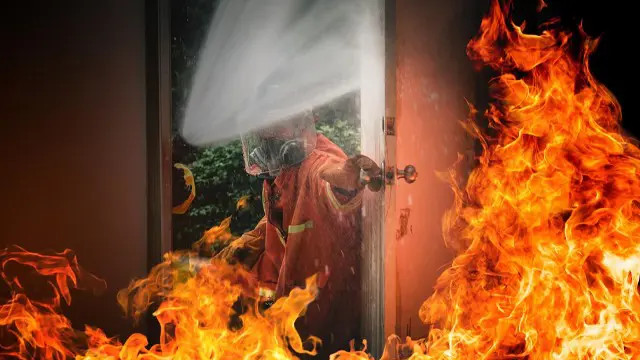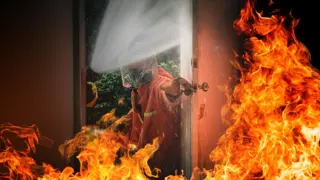
Fire Safety Training
Updated study materials |* Free Certificate *|* Designed by Industry Experts *| Instant Access | 24/7 Support
Course Line On Demand
Summary
- Reed Courses Certificate of Completion - Free
- Tutor is available to students
Add to basket or enquire
Overview
Welcome to Fire Safety Training, a comprehensive and engaging course designed to provide you with in-depth knowledge and practical skills in Fire Safety. Throughout this course, we will explore various aspects of Fire Safety and delve into its fundamental concepts, advanced techniques, and real-world applications.
Our primary objective in Fire Safety Training is to equip you with a solid foundation in Fire Safety. Whether you are a beginner or an experienced professional looking to expand your expertise, this course will cater to your needs and help you achieve your learning goals.
During our journey together, you will have the opportunity to:
- Gain a thorough understanding of the core principles and theories that underpin Fire Safety.
- Acquire practical skills through hands-on exercises, projects, and real-world examples.
- Explore cutting-edge advancements and emerging trends in the field of Fire Safety.
- Prepare for future opportunities, such as further education, career advancement, or entrepreneurship, in the field of Fire Safety.
- Reflect on your learning journey, celebrate your achievements, and gain the confidence to excel in Fire Safety.
By the end of Fire Safety Training, you will have gained a comprehensive understanding of Fire Safety and developed the skills necessary to succeed in this dynamic field. Whether you choose to pursue further education, enter the job market, or embark on entrepreneurial ventures, this course will lay a strong foundation for your future endeavours.
We are excited to have you join us on this educational journey, and we look forward to helping you unlock your full potential in Fire Safety Training. Let's get started!
Why should you choose Course Line?
When it comes to quality education and professional development, Course Line stands out as one of the most prestigious learning providers. As a certified institution by UKRLP & CPD Group, we have a proven track record of excellence, having successfully taught over 20,000+ students and counting.
Curriculum
-
Module 1 Introduction to Fire Safety 17:00
-
Module 2 Fire Safety Legislation 13:00
-
Module 3 Fire Chemistry 04:00
-
Module 4 Fire Risk Assessment 11:00
-
Module 5 Fire Safety Measures _ Fire Prevention 08:00
-
Module 6 Building Construction 17:00
-
Module 7 Fire Detection and Warning Systems 09:00
-
Module 8 Firefighting Equipment and Facilities 10:00
-
Module 9 Emergency Escape Routes 09:00
-
Module 10 Emergency Escape Lighting, Signs and Notices 10:00
-
Module 11 Rerecord, Plan, Inform, Instruct and Train 08:00
Course media
Description
Welcome to the course outline for Fire Safety Training. In this comprehensive learning journey, we will explore the depths of Fire Safety, delving into its core principles, practical examples, and advanced techniques. Through a series of engaging lectures and exercises, you will gain the knowledge and skills necessary to excel in the field of Fire Safety Training.
*****Fire Safety Training Course Syllabus*****
Module 1: Introduction to Fire Safety
- What is Fire?
- Fire Triangle
- Fundamentals of Fire Chemistry
- What is Fire Safety?
- Typical Fire Risks
- Prevention of Fire
- Measures to Prevent Fires
- Fixed Fire Fighting Systems
- Automatic Water Sprinkler Systems
- Portable Fire Fighting Equipment
- Siting of Portable Extinguishing Equipment
- Fire Alarm and Detection Systems
Module 2: Fire Safety Legislation
- England and Wales' Regulatory Reform (Fire Safety) Order 2005
- DSEAR Regulations
- What are dangerous substances?
- What are the requirements of DSEAR?
- Where does DSEAR apply?
- UK Fire Safety Legislation Simplified
- Fire Extinguishers
- Fire Safety Signs
- Fire Alarm Systems
- Emergency Lighting
- Fire Safety Training
Module 3: Fire Chemistry
- Introduction
- Definition of Fire
- Fire Triangle (Fuel, Oxygen, Heat)
- Fire Tetrahedron
- Classes of Fire (Incipient stage, free-burning stage, smouldering stage)
Module 4: Fire Risk Assessment
- What is a Fire Risk Assessment?
- Identifying fire hazards
- Identifying people at risk
- Evaluate, remove, reduce and protect from risk
- Checklist Evaluate, remove, reduce and protect from risks
- Record, plan, inform, instruct and train
- Fire Safety Training
Module 5: Fire Safety Measures & Fire Prevention
- Fire Risks and Preventative Measures
- Housekeeping
- Storage
- Dangerous Substances: Storage, Display and Use
- Equipment and Machinery
- Electrical Safety
- Smoking
- Managing building Work and Alterations
- Existing Layout and Construction
- Particular Hazards in Corridors and Stairways used as escape Routes
- Insulated Core Panels
- Restricting the spread of Fire and Smoke
- Arson
Module 6: Building Construction
- Facility Location
- The layout of Facilities (Planning, Floor Design, Flow Sheets)
- Life Safe
- Evaluating Life Safety
- Evaluating Building Construction
- Management Approaches for Assuring Life safety
- Building Codes
- International Building Codes
- Engineering Design Considerations for Plant Layout
- Location of Building and Structures
- Selection of Building Materials
- Compartmentalising Facility
- Explosion Prevention System
- Explosion Suppression System
- Installation of Utilities and Services
- Heating, Ventilating, and Air Conditioning
Module 7: Fire Detection and Warning Systems
- People with hearing difficulties
- Voice alarms
- Schematic plan
- Manual call points
- Automatic fire detection
- Reducing false alarms
- Staged fire alarms
- Testing and maintenance
- Guaranteed power supply
- New and altered systems
Module 8: Firefighting Equipment and Facilities
- Portable Firefighting Equipment
- Number and type of Extinguishers
- Foam extinguishers (cream)
- Powder extinguishers (blue)
- Carbon dioxide extinguishers (black)
- Fixed firefighting installations
- Other facilities (including those for firefighters)
- Access to fire engines and firefighters
- Smoke control systems
Module 9: Emergency Escape Routes
- The type and Number of People using the Premises
- The age and Construction of the Premises
- The Number of Escape Routes and Exits
- Management of Escape Routes
- Emergency Evacuation of Persons with Mobility Impairment
- General Principles
- Suitability of Escape Routes
- Fire-resisting Construction
- Number of people using the Premises
- Mobility Impairment
- Widths and Capacity of Escape Routes and Stairways
- Travel Distance
- Basement, Escape and Protection
- Roof Exits
Module 10: Emergency Escape Lighting, Signs and Notices
- Escape Signs
- Signs and notices
- Signs
- Installation, Testing and Maintenance
- Daily Checks
- Weekly Tests and Checks
- Monthly Tests and Checks
- Six-monthly Tests and Checks
- Annual Tests and Checks
- Positioning of escape signs
- Escape sign design
- Other Safety Signs and Notices
- Illumination
Module 11: Re-Record, Plan, Inform, Instruct and Train
- Fire Safety Records & Training
- Fire Safety Audit
- Plans and Specifications
- Emergency Plans
- Information, Instruction, Cooperation and Coordination
- Fire Safety - Fire Safety Training
- Fire Marshals
- Fire Drills
- Monitoring and Debrief
- Quality Assurance of Fire Protection Equipment and Installation
Assessment Process
Upon completing the Fire Safety Training course, you will be required to undertake a multiple-choice evaluation in order to gauge your understanding of the material covered.
If you do not achieve the minimum passing score, you will have the opportunity to retake the assessment without incurring any additional cost.
Certification
After successfully completing this Fire Safety Training course, you will get an instant Free digital certificate.
Who is this course for?
Fire Safety Training is designed to cater to a wide range of individuals who are eager to enhance their knowledge and skills in Fire Safety.
This course is suitable for:
- Beginners in Fire Safety
- Professionals
- Students
- Career changers
No matter your background or level of experience, Fire Safety Training offers a comprehensive learning experience that caters to your specific needs. Join us on this educational journey and unlock your potential in Fire Safety today!
Requirements
Requirements for the Fire Safety Training course:
- No Prior Knowledge Required
- Basic Computer Skills.
- Internet access.
- Familiarity with English
Career path
Completing Fire Safety Training course can open exciting career opportunities in various fields related to Fire Safety. Here are three potential career paths you can pursue after completing Fire Safety Training:
- Fire Marshal
- Fire Safety Supervisor
- Fire Marshall
- Fire Warden
- Firefighter
- Banksman
- Health and Safety Officer (HSE)
Questions and answers
Currently there are no Q&As for this course. Be the first to ask a question.
Certificates
Reed Courses Certificate of Completion
Digital certificate - Included
Will be downloadable when all lectures have been completed.
Reviews
Currently there are no reviews for this course. Be the first to leave a review.
Legal information
This course is advertised on reed.co.uk by the Course Provider, whose terms and conditions apply. Purchases are made directly from the Course Provider, and as such, content and materials are supplied by the Course Provider directly. Reed is acting as agent and not reseller in relation to this course. Reed's only responsibility is to facilitate your payment for the course. It is your responsibility to review and agree to the Course Provider's terms and conditions and satisfy yourself as to the suitability of the course you intend to purchase. Reed will not have any responsibility for the content of the course and/or associated materials.


